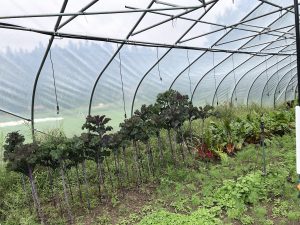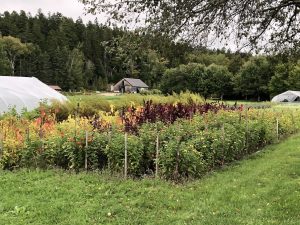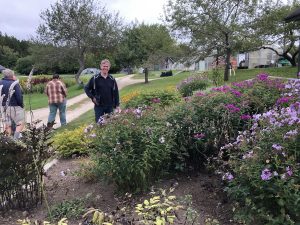Master Gardener Volunteers – Hancock County Newsletter – October 2024
Table of Contents
SAVE THE DATE / SAINT DUNSTAN’S / AUTUMN REVEALS ARTICLES / FOUR SEASON FARM / BUZZ ON NATIVE PLANTS / WILD SEED PROJECT / MGV BOOK CLUB
Upcoming Dates to Remember!
Oct 14 Indigenous Peoples’ Day – Office Closed
Nov 4 MGV Advisory Meeting – ZOOM
Nov 11 Veteran’s Day – Office Closed
Nov 14 MGV Fall Gathering Event – Moore Center – Watch for Details!
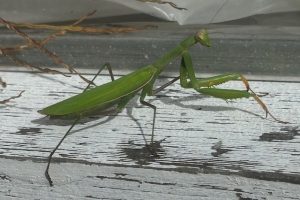
It is officially Fall. The deciduous trees and fall flowers are showing their autumnal colors and many of our perennials have gone by.
We were finally able to meet our new MGV coordinator, David (aka Dave) Lowe, at the Extension Office in Ellsworth. He was greeted by the Friday afternoon volunteers as well as Patty Persson, Mary Doherty, and Sue Baez, our Administrative Support Supervisor extraordinaire.
We toured the offices with Sue and the rest of the office staff and we were treated to an introduction to the aquarium and fish at the office by Leah McCluskey, 4-H Community Education Assistant. We proceeded to the gardens and hoop house and had a discussion about what needs to be done to renovate and repair the hoop house. I’m sure the praying mantis at the hoop house approved. From there we walked up to show David the garden at the Hancock County Technical Center which had tomatoes and a fair amount of butternut, buttercup, and acorn squash all ready for harvest.
Save the Date!
Our MGV Fall Gathering event will take place on Thursday, November 14th from 5-7 PM. Watch your email for an Invitation with details & RSVP info in the coming week.
MG Project Profile ~ St. Dunstan’s Creation Garden
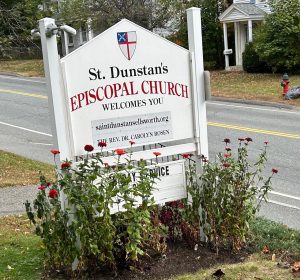 By Jody Blake, MGV
By Jody Blake, MGV
There is a gem that exists at St. Dunstan’s Church on State Street in the heart of downtown Ellsworth. I had never noticed it, despite driving by many times. The idea of the Creation Garden was conceived in 2017 by Reeser Manley; it is supported by the Ellsworth Garden Club, St. Dunstan’s Church, and the Master Gardener Volunteers of Hancock County. In addition, local businesses also contribute; Hutching’s Greenhouse in Eddington donated between $100-200 worth of seedlings just this year.
Reeser’s idea was to reduce the size of the lawn surrounding the church, and replace it and the existing gardens with native species. The garden’s transformation was a two-year project. There is a plaque at the garden which was erected to explain the gardens and their purpose. It reads in part: “This landscape was transformed into a collection of ecologically functional plants that provide a safe haven for urban wildlife”.
I met with Dan DeLong, an MGV who has been a dedicated volunteer since the beginning. He is one of the core group of devoted gardeners, which also includes Tom Hancek, Bob Peplar, Anita Findlen, Molly Shields, Pier Carros (MGV), and Marjorie Peronto. Despite being a small area, it is packed with native species which make up 85-90% of the gardens, according to Dan.
Annuals, such as zinnias, are added for continuous color; some non-native perennials that attract many pollinators are included as well. The stunning Norway Maple out front also remains. Some of the plants I observed were Winterberry, Black Chokeberry, Gooseneck Yellow Loosestrife, Pokeweed, Creeping Juniper, Indian Blanket Flower, Mint, Rhododendron, Hydrangea, Dwarf Hydrangea, Globe Thistle, Lamb’s Ears, Joe Pye Weed, Plumbago, Blueberry, Fothergilla, Asters, Blue Giant Hyssop, Sweet Fern, Eastern Hayscented Fern, Elderberry, Allium, Viper’s Bugloss, Sweet Pepperbush, Northern Bayberry, and Milkweed.
These gardens were created to promote native species, protect wildlife, and, encourage people to make their own Creation Gardens, as Reeser Manley so thoughtfully and brilliantly showed us all. Please come, enjoy, and learn!
Saint Dunstan’s is located at 134 State St. It is open to the public early Spring through Autumn, and visitors are welcome to walk through the gardens, using reference materials available in the Information Box. Groups may schedule a tour guided by a garden docent. (207) 667-5495.
- Saint Dunstan’s Gardens Interpretive Sign
Autumn Reveals Invasive Look-Alikes
 As foliage thins during our autumn leaf changes, this is a particularly good time to notice plant stems, leaf arrangements, and petioles (the stalks that attach leaf blades to stems). These observations can help you identify some common plant tricksters—invasive species that look like some of our desirable native plants here in Maine. Two common plants come to mind, one in the genus Rosa and one Viburnum.
As foliage thins during our autumn leaf changes, this is a particularly good time to notice plant stems, leaf arrangements, and petioles (the stalks that attach leaf blades to stems). These observations can help you identify some common plant tricksters—invasive species that look like some of our desirable native plants here in Maine. Two common plants come to mind, one in the genus Rosa and one Viburnum.The first example is the easiest: the multiflora rose (R. multiflora) can mimic two of Maine’s lovely native roses, R. virginiana and R. carolina. While R. carolina is generally smaller than R. virginiana (height 2-3 feet versus 4-6 feet), these two species have much in common. They are lovely, drought tolerant, disease-resistant, suckering shrubs often seen in fields and hedgerows throughout Maine. Throughout the year, they are a host plant to a variety of native insects, small mammals, and birds. In June, they display attractive deep pink, fragrant flowers (3-4 inch diameter) with 5 single petals amidst lustrous green foliage comprised of greenish to red thorny stems and compound leaves. Attractive, bright red hips mature on both in autumn, as their foliage turns vibrant shades of red-orange to purple. While both species have slightly different stipules (paired appendages at the base of the petiole), the stipules are small and smooth-edged in both (Photo A).
Mature multiflora rose shrubs, on the other hand, are often quite distinctive, reaching up to 10-15 feet in height and width, and forming fast-spreading, often impenetrable masses, with long arching, thorny branches that root easily where they touch the ground to begin new clonal plants. Unlike our natives, R. multiflora has branched clusters of 20 to 100 flowers. While each flower is similarly 5 petaled, they are white and generally smaller than native blossoms ( 1-2 inch diameter). They form bright red, clustered hips that can contain up to 500,000 seeds per plant per year, which are easily spread by hungry birds. This vigorous seed production, along with their ability to reproduce both from root sprouts and cane layering, account for their invasive habit. But while the mature plants are often formidably recognizable, when not loaded with flowers or fruit, or as juveniles, they can be more difficult to distinguish from our native roses. Like our natives, they often have green to greenish-red stems and thorns, and green compound leaves. However, luckily, they can be easily identified by the paired, fringed stipules at the base of their established leaf stems (petioles), a characteristic not seen in our native roses (Photo B). This unique characteristic can assist you to identify and eradicate them before they reach unmanageable sizes and spread.
The second example is the relatively invasive European Viburnum opulus, or the Guelder Rose. With its clusters of lacy white, flat-topped flowers in late spring, followed by bright orange-yellow three-lobed foliage and clusters of bright-red, round, translucent berries in autumn, this ornamental spreading, deciduous shrub is well-loved in its original Eurasia. In fact, it’s one of the national symbols of Ukraine, and a popular ornamental in the United Kingdom, despite the berries being mildly poisonous, with an unpleasant odor and bitter taste when raw. Also, unfortunately, V. opulus is very adaptable, and can out-compete several of our native viburnum, including V. opulus var. americanum (formerly V. trilobum), popularly called the highbush cranberry, and V. dentatum, the Arrowwood viburnum. In much of Maine, the introduced European species has naturalized widely, and is often more common than our native varieties. Our native variety of V. opulus is very similar in appearance to its European relative, but the berries have a better flavor, and presumably evolved with the native species it hosts. The key to differentiating them by appearance lies in the petiolar glands. These glands appear on the leaf stem, sometimes just below the leaf itself, sometimes along the length of the petiole, but not at the attachment, as was the case with the rose stipules. With a magnifying glass, you’ll be able to differentiate: the European variants have concave (sunken) tops on their petiolar glands (Photo C), whereas native species have convex (rounded) glands! (See Photo D). It’s a fun challenge and important to at least try to distinguish between the two varieties, as they can both out-compete and hybridize and eliminate our wild stock
One other native viburnum, the more distantly related V. acerifolium (Maple leaf viburnum), has characteristics that make it less likely to be mistaken for its European cousin, but it is still threatened by the hardiness of the invasive species. V. acerifolium is generally a smaller shrub (4 by 3 feet tall versus 15 by 10 feet for V. opulus), and tolerates shade better. While it does have smaller, but similar three-lobed leaves and flower-clusters, its key differentiator in the autumn is its pea-sized bluish-black fruit, at variance to the bright red berries of the opulus species.
So, enjoy autumn, and take the time to look closely; it’s easy to miss some of our most prolific invasive plants in other seasons, but in autumn, they just may be revealed.
Sources:
Fedco Trees catalog, 2025. Fedcoseeds.com/trees
Lady Bird Johnson Wildlife Center www.wildflower.org
Maine Audubon Society. Maine Native Plants: mainenativeplants.org
Missouri Botanical Garden, Viburnum acerifolium: www.missouribotanicalgarden.org
Native Plant Trust. Rosa virginiana. GoBotany.nativeplanttrust.org
The Heart of England Forest. Guelder Rose. heartofenglandforest.org
University of Connecticut, Crop Protection and Pest Management Program. Invasive Plant Factsheet: Multiflora Rose. rpm.cahnr.uconn.edu
Cranberries. www.extension.umaine.edu/cranberries/
Woodland Trust. www.woodlandtrust.org.uk
Four Season Farm Tour
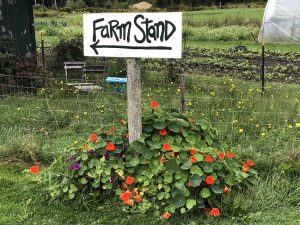 By John McClement, MGV
By John McClement, MGV
On a foggy/rainy September Saturday morning an intrepid group of MGV’s and friends made their way through seemingly suspended drops of rain the size of cultivated blueberries to the far reaches of Cape Rosier in Brooksville to hear stories and tour the iconic Four Season Farm.
We had received the unfortunate news that the Saturday morning farm market had closed for the season the previous week but this did not stop some from packing a lunch and dining alfresco. And YES, the weather vastly improved once we arrived at the farm and found dry conditions to chat and nosh unhindered by the earlier rain!
Soon after we had a chance to eat and catch up, farmers and writers Eliot Coleman and Barbara Damrosch, and new farmer Molly Friedland, arrived to regale us with tales from 55+ years of farming and then give us an in-depth tour of the gardens and facilities.
Four Season Farm was purchased by Eliot from back-to-the-land pioneers Scott and Helen Nearing from 40 acres of forested land they were not using in 1968. Eliot spent the next few years trying to eke out a living while clearing spruce and fir forest with 2 inches of topsoil, a LOT of rock, and a PH of 4.3. Time, tremendous effort, and additives in the form of limestone, homemade compost, seaweed, and deep-rooted green manures enabled them to turn the initial 2 acres into a beautifully fertile market garden.
Over time the cleared land grew to 14 acres which included 7 acres of vegetables and flowers with movable greenhouses, and the balance for field crops, farm buildings, infrastructure, and residences all protected by more or less dependable deer fencing.
After being regaled with stories from both Eliot and Barbara and having an in-depth discussion of the failure of the USDA to ensure that organic farming is indeed organic (hello Hydroponic, show us how you qualify??) we were formally introduced to Molly Friedland who some of you might know as the proprietor of the Little Red Flower Truck. Molly and her husband Caleb Hawkins officially took over farming in early 2024 and are navigating the waters of having both an intensive new business and a new baby!
We then set out touring the grounds and infrastructure including the 3000sf stationary greenhouse with heat, washing stations, walk-ins, propagating and starting facilities, and a root cellar. From there we saw the various beds throughout the property and other farm facilities. Eliot and Barbara joined us for the earlier part of the tour and then handed the guide duties to Molly who shared some of the joys and challenges of their first year farming this hallowed piece of ground.
All in all, we had a fantastic afternoon, learned a lot, got an insight into the intricacies of our failing governmental systems, and came away with even more respect for the immensely hard work of farming.
BTW, Barbara has a new book out this month called A Life In The Garden filled with gardening tips, anecdotes, and tales of 50+ years in the flower and vegetable biz. Check it out!
The Buzz on Native Plants
The Buzz on Native Plants is a film that explores the relationship between native plants and pollinators and how they can benefit local ecosystems in our changing climate.
The goal of the film is to raise awareness about the importance of biodiverse native ecosystems in our changing climate.
It will supposedly be aired on PBS in November, but I don’t have dates yet. Will follow up when the dates are confirmed. In the meantime, there is a link to the 3-minute trailer you can find here: https://www.mooseyproductions.com/films/nativeplants
Wild Seed Project
Wild Seed Project’s motto is Restoring biodiversity and building climate resilience, one seed at a time. The organization was founded by Heather McCargo. It was originally based in Blue Hill and is now based in North Yarmouth.
Wild Seed Project Home Page has links to some valuable blog posts, videos, Programs & Events. Some of the links include Autumn and Winter Seed Sowing in Six Easy Steps, Leave the Leaves, and Why Native Plants Matter. They also have some excellent publications.
Wild Seed Project Online Store – the link to buying Native Seeds
MGV Book Club
Please join us!
The Hancock/Washington County Master Gardeners’ Book Club meets once a month, September through May (skipping the month of December) starting at 9 am each third Thursday of the month. Those in attendance find being in touch with other Master Gardeners is energizing and learning together to be rewarding. We meet at the Moore Community Center (Friends in Action Area) at 5 General Moore Way Ellsworth. The books are typically intriguing and focus on some aspect of the natural world.
ALL are welcome. Should you want to ask any questions regarding the book club, please contact this year’s coordinator, Jane Ham at jdham48@gmail.com
Our September book was What an Owl Knows by Jennifer Ackerman. It’s a marvelous book and it triggered a great discussion.
October 17, 2024 Why Fish Don’t Exist: A Story of Loss, Love, and the Hidden Order of Life by LuLu Miller, 240 pp
Part biography, part memoir, part scientific adventure, Why Fish Don’t Exist reads like a fable about how to persevere in a world where chaos will always prevail. It is a dark and astonishing tale of chaos, scientific obsession, love, and (possibly)even murder. It interweaves a biography of David Starr Jordan – a taxonomist who is credited with discovering nearly a fifth of the fish known to humans in his day and possessed by the need to bring order to the natural world – with the author’s own search for how to go on when all seems lost.
November 21, 2024 Alfie & Me by Carl Safina, 384 pp
When ecologist Carl Safina and his wife, Patricia, took in a near-death baby owl, they expected that, like other wild orphans they’d rescued, she’d be a temporary presence. But Alfie’s feathers were not growing correctly, requiring prolonged care. As Alfie grew and gained strength, she became a part of the family, joining a menagerie of dogs and chickens and making a home for herself in the backyard… Witnessing all the fine details of their feathered friend’s life offered Carl and Patricia a view of existence from Alfie’s perspective.
January 16, 2025 Soil: The Story of a Black Mother’s Garden by Camille T. Dungy, 352 pp
Poet and scholar Camille T. Dungy recount the seven-year odyssey to diversify her garden in the predominantly white community of Fort Collins, Colorado. When she moved there in 2013, with her husband and daughter, the community held strict restrictions about what residents could and could not plant in their gardens.
February 20, 2025 Scientist E. O. Wilson: A Life in Nature by Richard Rhodes, 304 pp
“The scientist, naturalist, and two-time Pulitzer winner – who died in 2021 – ‘popularized the term ‘biophilia,’” our reviewer Andrea Wulf explained, ‘defining it as the love for the natural world and ‘the rich, natural pleasure that come from being surrounded by living organisms.”
March 20, 2025 Brave the Wild River: The Untold Story of Two Women Who Mapped the Botany of the Grand Canyon by Melissa L. Savigny, 304 pp. “In 1938, the botanists Elizada Clover and Lois Jotter overcame critics and a doubtful press to make a contribution to their field that informs science to this day, as Sevigny demonstrates in her lively history.”
April 17, 2025 Of Time and Turtles by Sy Montgomery, 304 pp
“Compassionate and deeply researched, warm and astonishing, this book is an invitation to slip into turtle time – not the tick-tock hurry of human hustle, but the sacred, eternal time of daylight, darkness, and seasons. It’s a story that shows us a way to mend a world beset with unprecedented perils, shell by shattered shell.”
May 15, 2025 Book Selection discussion for 2025-2026 book list
Take lots of pictures of your MGV projects!
Send them Sue Baez at sue.baez@maine.edu for use in future newsletters and the Recognition Event videos.
We are always on the lookout for articles you’d like to see here, or topics you would like to write about. You will get MGV hours for time spent writing. Contact Betsy Adams for information at bluehilldesign@gmail.com.
This newsletter gets sent to about 130 people every month. Do you know an MGV who doesn’t receive the newsletter and would like to? Let us know! MGVnewsletterinput@gmail.com
Thank you from the Newsletter Committee
Betsy Adams, Mary Doherty, Nicole Gurreri, Jane Ham, Mary Hartley, and Jan Migneault.





